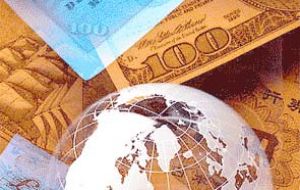MercoPress. South Atlantic News Agency
UK pound and Euro reach new highs against US dollar

With a growing perception that US interests rates will be cut this week while UK interest rates will remain unchanged next week, the pound sterling hit its highest level against the US dollar in 26 years.
When UK rates are higher than US rates, investors are encouraged to exchange dollars for pounds to benefit from better rates of return. At one point on Tuesday trading the pound touched $2.070, before paring gains to $2.067, while the dollar sank to a new Euro low. The last time the pound was at these sorts of levels was 5 November, 1980, when it reached 2.446 US dollars. A majority of analysts expect the Federal Reserve to cut interest rates by a quarter of a percentage point on Wednesday, in an attempt to limit the impact of a housing market slowdown. The Fed cut its main interest rate by half a percentage point to 4.75% from 5.25% last month, after problems in the housing market were seen to be spreading to the wider economy. The move sent the greenback in a downward spiral against the Euro, sliding to a new record low on Tuesday at $1.4444, its third record low in as many days. House prices in the US have been falling and the number of foreclosures has surged in recent months after the Fed spent almost two years between 2004 and 2006 raising rates in an attempt to slow inflation. While inflation fears have been simmering in previous months, mainly stoked by the surging oil price, many analysts now say that the biggest worry is consumers reining in their spending. Should that happen, they argue, the US economy could splutter into a recession. The next decision from the Bank of England's interest rate setters is due on 8 November, when they are expected to leave rates unchanged at 5.75%. The perception that there will be no change has been strengthened by comments from one of the Bank's policy makers, Kate Barker. In an interview with the Guernsey Press and Star, Ms Barker was reported to have said: "We are asking ourselves if things are so different from August and do we actually have to cut rates?" The pound is still some way off the $2.446 mark it reached in November 1980, but some analysts believe it could threaten those levels if economic conditions in the UK and US continue to diverge. But while the weak dollar is good news for British travelers planning trips to the US in the run-up to Christmas, it makes the reverse trip for Americans much more expensive. The number of visitors from North America fell in the first six months of 2007. The strong pound is also inconvenient for British firms exporting goods across the Atlantic.




Top Comments
Disclaimer & comment rulesCommenting for this story is now closed.
If you have a Facebook account, become a fan and comment on our Facebook Page!